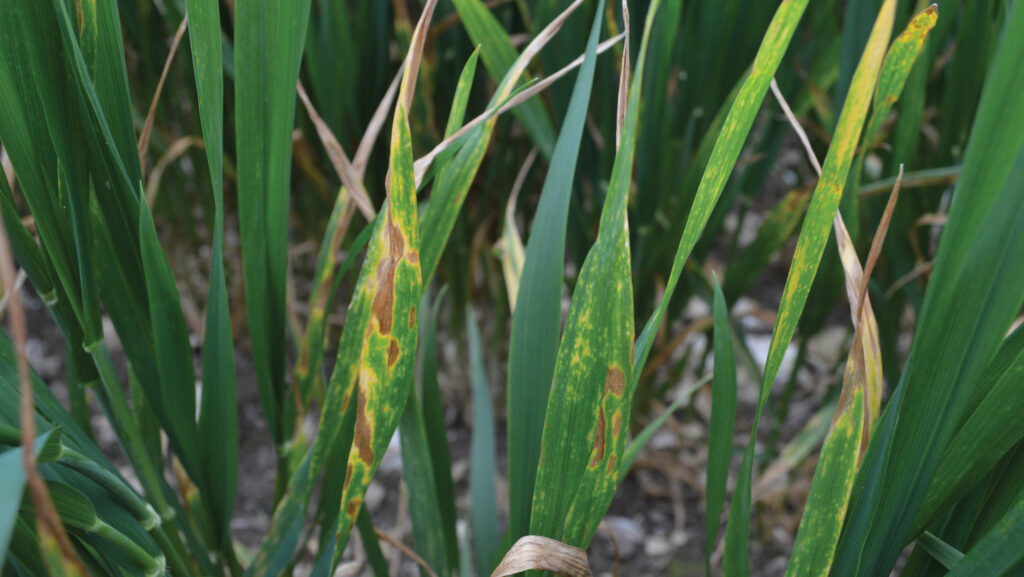Dorset grower hopes for lift from septoria-hitting SDHI
 ©David Jones
©David Jones Bob Rowe is turning to a new hard-hitting septoria fungicide across all his 700ha of winter wheat at the crucial T2 flag leaf timing later this month to gain from top disease control and an expected yield uplift.
In a wet and windy spring, ideal for the spread of yield-robbing septoria, he is set to use the new SDHI fungicide Miravis Plus across all five of his wheat varieties on his east Dorset farm.
See also: How farmers will benefit from new SDHI wheat fungicide at T2
The new fungicide from agrochemical giant Syngenta was only cleared for use in Britain in early April, just in time for all-important flag-leaf sprays which start to be applied from mid-May onwards.
As a new product with strong septoria activity, it is likely to be priced at a premium to rivals, but Bob believes that because of its better disease control and yield advantage it is worth spending a bit more on his wheats, which show average yields of 10.5-11.0t/ha.
“To sustain high yields in bad septoria years you can not take your foot off the gas,” he tells Farmers Weekly after he had applied a comprehensive T1 fungicide in April with a T2 pending.
Fungicide spend

Bob Rowe © David Jones
Bob farms 1,700ha of chalky arable-cropped land with clay caps, and is pencilling in a fungicide spend of £145-£160/ha this season, encouraged by a feed wheat price of over £200/t for later this year.
He has witnessed the high yield response from Miravis Plus, or Adepidyn, from Syngenta trials on his farm and other local trial sites, and is impressed with the product’s ability to give extended green leaf retention through the summer months.
“I see it as a game changer from what we have seen from the Syngenta trials on the farm, which showed the extra difference in septoria control,” he says.
Key wheat fungicides
Mixtures
- Ascra – SDHIs bixafen + fluopyram + azole prothioconazole
- Elatus Era – SDHI benzovindiflupyr (Solatenol) + prothioconazole
- Miravis Plus – SDHI pydiflumetofen (Adepidyn) in twin pack with prothioconazole
- Revystar – SDHI fluxapyroxad (Xemium) + azole mefentrifluconazole
- Univoq – picolinamide fenpicoxamid (Inatreq) + prothioconazole
- Vimoy – SDHI isoflucypram (Iblon), in twin pack with prothioconazole
Straights
- Elatus Plus – benzovindiflupyr (Solatenol)
- Imtrex – fluxapyroxad
- Myresa – mefentrifluconazole/Revysol
- Peqtiga – fenpicoxamid/Inatreq
Syngenta says Adepidyn has high efficacy against septoria and will be available in a co-pack with the widely used azole prothioconazole.
The group says Adepidyn gives moderate control of brown rust, but yellow rust is not on the label, and so rust control will be largely relying on prothioconazole.
Independent trials point out that the new SHDI gives a 0.4t/ha uplift in wheat yields over a number of years when compared with the next most effective septoria active, namely Inatreq.
Septoria threat
Based at Manor Farm, Gussage St Michael, about six miles north-east of Blandford Forum, Bob’s main wheat disease concern is septoria with rust diseases often not a major problem on a farm with over 1,000mm of annual rainfall.
“It’s perfect septoria weather with showers through April and May, low temperatures and winds which cause disease spread by leaves rubbing together,” he says.
Annual rainfall in this part of east Dorset just tipped over 1,000mm compared with 780mm some 40 years ago, heightening the threat from the wet-loving septoria.
Night temperatures during April dropped to as low as 1C and then day temperature often rose to 14C.
This wide swing in temperature stressed wheat plants while leaves rubbing in the wind helped to spread septoria from infected leaf fours to newly emerging leaves.
Keeping the top two leaves clean is important as 65% of wheat yield comes from the flag leaf and leaf two, and when Farmers Weekly visited in late April, fully emerged leaf threes were clean just after a T1 fungicide had been applied.

Leaf threes were clean © David Jones
The T0 spray this season only included a non-fungicide biological product in the form of Iodus, which helps stimulate the defence mechanism of the plants, across his five wheat varieties, namely Champion, Redwald, Extase, Palladium and Oxford.
Some 220-250kg/ha of nitrogen is used.
All varieties have good septoria resistance scores ranging from Champion at 7.9 to Redwald at 6.5 in the AHDB Recommended List’s 1-9 scale where 1 is very susceptible and 9 shows good resistance.
T1 spray
He decided to upgrade his T1 approach this disease-prone spring moving from SDHI-azole Ascra to another new SDHI-azole for this season, Vimoy (Iblon) from Bayer, which like Miravis is co-packed with prothioconazole.
Bob says Vimoy is more effective against septoria than Ascra and is also good on stem-based diseases, especially sharp eyespot, which can be a problem when wheat is grown after peas. He added the rust-active azole tebuconazole to boost brown rust control.
This added azole was especially useful for Champion and Palladium, which have only moderate resistance to brown rust and are scored at 5s, whereas Extase and Oxford are 6s and Redwald a 7.
T2 spray
His planned T2 will be Adepidyn, but he will save the co-packed prothioconazole for later on his wheat or other crops, and use the leading azole mefentrifluconazole which will boost septoria activity and, more importantly, rust control.
“We are going to use the best SDHI and the best azole, and using the later will take the rust problem away,” he says,
The co-packed prothioconazole could be used with strobilurin azoxystrobin (Amistar) as a competitively-priced T3 wheat ear spray, or used on the farm’s Laureate spring malting barley crop.
As a possible way on trimming fungicide costs, he is experimenting with wheat blends with a 14ha block consisting of a four-way mix of Champion, Redwald, Extase and Oxford, which he hopes may give him an extra 0.4-0.5t/ha in yield.
This hoped-for yield lift and the persistence of Adepidyn when applied at T2 may allow him to omit a T3 head spray on the wheat in the future.
He is also interested in trying out the fungicide on his 160ha of Caravelle winter barley, as the product has shown good control of troublesome ramularia.
SDHI in detail
Syngenta describe pydiflumetofen as a third-generation SDHI fungicide, following first generation SDHI boscalid launched in 2003, and second generation SDHIs such as bixafen, fluxapyroxad and benzovindiflupyr after 2011.
It can be applied to winter wheat at growth stage 30-69, or from the end of tillering to the end of anthesis/flowering, and can only be applied once in a season.
It is expected to be aimed at the T2 flag leaf stage. It is also cleared for use on other cereals such as barley and oats up to GS65.
Sold in a co-pack with prothioconazole, Syngenta say the combined product will be “priced competitively given its efficacy”.
The newly-approved SDHI is set to compete with another new SDHI Iblon also co-packed with prothioconazole from Bayer, SDHI-azole combination Revystar from BASF and also Univoq from Corteva.
The AHDB says Miravis gave an average 0.4t/ha yield response in single-spray independent septoria wheat trials over the last three years compared with Peqtiga, the next most effective active, when compared at full dose rates.
It adds the new SDHI has useful actively on brown rust, but is not as active as Vimoy, Elatus or Imtrex, and will add to the efficacy of partnered products.
On fusarium, it has shown excellent activity compared to the azole standard treatment prothioconazole.
Control of yellow rust is not on the Miravis label, but when mixed with co-pack partner prothioconazole it will have activity against this foliar disease.
In barley trials, Miravis has shown much better control of ramularia, compared with previous leading product mefentrifluconazole which itself was more effective than the other long-established standard prothioconazole.
Against rhynchosporium, Miravis consistently performed as well as or better than existing standards, and on average increased yields by 0.3t/ha compared with Imtrex, the next most effective solo active.
In net blotch trials, Miravis gave consistently better control than existing azole-based standards, and better than the other straight SDHI in trials, Imtrex.

